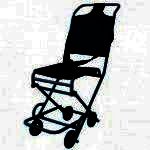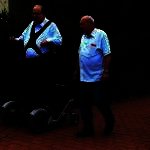So imagine having a squeaking shoe that you cannot take off ! this is what it’s like at times with my wheelchair only there are squeaks galore particularly when the weather is damp. A wheelchair is no different to any other simple mechanical device like a bicycle and does therefore need a basic level of maintenance to keep the wheels turning smoothly.
A well maintained wheelchair should provide many years of reliable service and part of that servicing includes applying some lubricating oil or even better bike grease to the parts that move. Electric wheelchairs or powerchairs are no different although they do tend to have more components that require a bit of oil.
So let’s look at the parts that may be squeaking on your wheelchair. These are typically:
- wheelchair castors
- wheelchair rear wheels
- wheelchair brakes
Wheelchair lubrication
The first thing to do is to clean the offending parts thoroughly with a soft brush to remove any dust or debris that may be causing the wheelchair to squeak. It is sometime necessary to partially disassemble the offending part to do this properly, depending on which part it is. Once cleaned, check it for lubrication and if there is none evident then apply some oil or grease. It’s best not to go overboard at this point as an excess will attract more dust and cause the process to repeat.
Once you have completed these two stages it’s time to reassemble the wheelchair and roll it round to see if the squeaking has ceased. It could be at this stage that you have cured one squeak and need to attend to others if the wheelchair continues to squeak. Take care when reassembling the wheelchair not to over tighten nuts or bolts as this can be the cause. In some cases, loosening of just half a turn will be enough to stop the noise.
Having done some research online we have also found stories of folk who have located the sound and found it to be coming from the wheelchair tyres, although this is described more as a groan than a squeak. Often this has been cured by adding some pressure to the wheelchair tyre or in some cases replacing it when it was worn.
Check the bearings on your wheelchair
Bearings are also a common cause of a squeaking wheelchair and need to be checked for wear and tear and also for adequate lubrication, although this is more common on electric wheelchairs. Bearings are considered non-durable parts and therefore will require replacement after a certain amount of use.
Finally, one persistent problem found by some users of self propelled wheelchairs is actually down to the spokes believe it or not. Although this type of noise on a wheelchair is often described as a groan rather than a squeak. If you feel that this could be the issue with your wheelchair then a trip to the local bike store is probably the best bet as they are experienced in trimming spoked wheels, which are much the same on a bike as a wheelchair. If this doesnt fix it we sell new spoked wheels for your self propelled wheelchair here




















